How To Get Home On Iphone Xr
iPhone XR
Contents
- iPhone XR
- iPhone XR Price
- iPhone Overview Guide
- Design
- Color Options
- Water and Dust Resistance
- Display
- Haptic Touch
- A12 Bionic Processor
- Neural Engine
- RAM and Storage Space
- Face ID and the TrueDepth Camera System
- Face ID Security and Privacy
- TrueDepth Camera Specs
- Animoji and Memoji
- Rear Camera
- Video Capabilities
- Battery Life
- Fast Charging
- Wireless Charging
- Connectivity
- LTE Advanced
- Dual-SIM Support
- Bluetooth and Wi-Fi
- GPS and NFC
- iPhone XR Timeline
The iPhone XR, introduced on September 12, 2018, was sold alongside more expensive iPhones up until 2021, when it was discontinued by Apple. The iPhone XR is no longer for sale and it has been replaced by the iPhone 13, iPhone 12, and iPhone 11 models.
The iPhone XR features a precision-machined 7000 Series aerospace-grade aluminum frame that wraps around an all-glass enclosure with the same durable glass used in the more expensive iPhone XS. Apple designed the iPhone XR in six colors: white, black, blue, coral, yellow, and (PRODUCT)RED.

With the glass body, Qi-based wireless charging is supported, and the device features IP67 water resistance for keeping it safe from splashes and spills. iPhone XR features a larger display than the previous-generation iPhone 8 Plus, but in a smaller body that falls between the 5.8-inch iPhone XS and the 6.5-inch iPhone XS Max it was introduced alongside.
Apple designed a new "Liquid Retina" display for the iPhone XR, which is a 6.1-inch LCD with a 1792 x 828 resolution that spans from edge-to-edge and top to bottom with minimal bezels. As with the iPhone XS, there is no Home button on the iPhone XR and it adopts the swipe-based navigation system introduced in the iPhone X.
Apple called the Liquid Retina display the most advanced LCD ever in a smartphone with support for 120Hz touch sensing, Tap to Wake, and wide color. It supports True Tone to match the white balance of the display to the ambient lighting in the room, and Apple says it has impressive color accuracy.
The LCD does not support 3D Touch, but Apple introduced a new Haptic Touch feature to provide haptic responses to certain gestures on the device as a replacement.
Instead of Touch ID, the iPhone XR uses the same TrueDepth camera system that's in the iPhone XS with faster, more efficient Face ID facial recognition for unlocking your device, making Apple Pay payments, and more.
Inside, the iPhone XR is sporting a 7-nanometer A12 Bionic chip that includes two-performance cores 15 percent faster than the A11 and four efficiency cores up to 50 percent more efficient. The four-core GPU in the A12 is up to 50 percent faster than the A11.
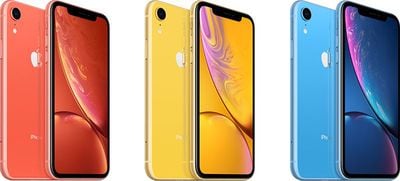
An 8-core Neural Engine completes up to 5 trillion operations per second for major improvements to all apps and features that use AR and machine learning. iPhone XR does not use a dual-lens camera system like in the iPhone XS or iPhone 11, instead adopting a single-lens rear camera, but Apple has made software advances to make it nearly as functional as the dual-lens camera in the more expensive iPhone XS models.
It features an f/1.8 12-megapixel wide-angle lens with a 32 percent larger sensor for sharper, more detailed pictures in low light, which is in fact the same wide-angle camera used in the iPhone XS. The camera supports optical image stabilization, improved True Tone Flash, and it has twice as many focus pixels.
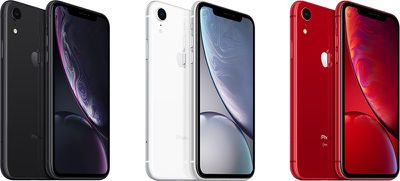
Through software, Apple enabled Portrait Mode in the iPhone XR, a feature previously limited to dual-lens cameras. Portrait Mode allows users to take DSLR-quality images with artful background blur that focuses the image on the subject of the photo. Advanced bokeh for better blur and Depth Control have also been introduced, allowing for the depth of field of a photo to be adjusted after it's captured.
Smart HDR brings out more detail in highlights and shadows even in situations where lighting conditions are poor, and wide color support results in rich, colorful photographs.
At the front, the 7-megapixel TrueDepth camera enables all of the features that are available in the more expensive iPhone XS, including Portrait Mode, Portrait Lighting, Depth Control, and more, for what Apple says are the "best selfies you've ever taken."
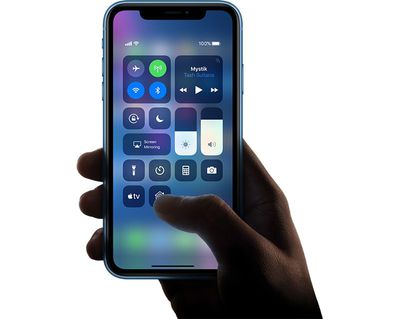
When it comes to battery life, the iPhone XR had the longest battery life of any Apple iPhone at the time of its introduction, although that's no longer the case with significant increases in battery life for Apple's 2019 iPhone lineup. The battery in the iPhone XR does, however, last for an hour and a half longer than the iPhone 8 Plus, offering 25 hours of talk time or 15 hours of internet use.
Other iPhone XR features include dual-SIM support with one nano-SIM and one eSIM, Apple Pay, LTE Advanced with 2x2 MIMO, support for 25+ LTE bands, and Bluetooth 5.0.
As of the release of the iPhone 12 lineup, the iPhone XR is available in 64 and 128 GB storage capacities and pricing in the U.S. starts at $499.
Note: See an error in this roundup or want to offer feedback? Send us an email here.
iPhone XR Price
The iPhone XR is available for purchase in Apple retail stores, the Apple online store, and from third-party retailers. Prices for the iPhone XR starts at $499 for the 64GB model, while a 128GB model is available for $549. Apple also occasionally sells refurbished iPhone XR models with refurbished pricing starting at $419.
AppleCare+ is available for the iPhone XR for $149 for two years of coverage or $7.99 per month for ongoing coverage. AppleCare+ extends the warranty of the iPhone XR and it provides coverage for two incidents of accidental damage every 12 months with a $29 - $99 deductible. Enhanced AppleCare+ with Theft and Loss coverage (up to two incidents every 12 months with $149 deductible per theft or loss incident) is priced at $219 or $11.49 per month.
iPhone Overview Guide
If you want to see how all of the iPhones in Apple's current lineup compare, make sure to check out our dedicated iPhone guide, which has details on each iPhone along with buying suggestions.
Design
The iPhone XR looks similar to the 5.8-inch iPhone XS, but it features a bigger 6.1-inch display, so it's a mid-sized phone that fell between the iPhone XS and the 6.5-inch iPhone XS Max. It is smaller than the iPhone 8 Plus that it replaced, but with a larger screen.
Like the iPhone XS, the iPhone XR features an edge-to-edge display with slim bezels and no Home button, instead adopting a notch and the TrueDepth camera system for Face ID. Rather than using an OLED display, the iPhone XR is equipped with an LCD that has slightly thicker bezels than the XS due to the limitations of the LCD.

At the front of the XR, there's a notch that houses the TrueDepth camera system, speaker, and ambient light sensor, but other than that, the iPhone XR is all display.
The iPhone XR features a glass body in one of six colors along with a matching 7000 Series aluminum frame, which is lighter and less expensive than the stainless steel frame of the iPhone XS. Like all of Apple's glass-backed iPhones, the iPhone XR is highly vulnerable to breaking when dropped.
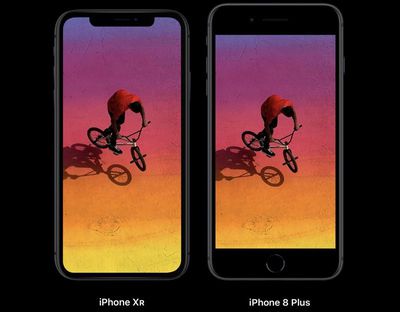
iPhone XR measures in at 150.9 mm tall, 75.7 mm wide, and 8.3 mm thick, which means it's thicker than the iPhone XS and iPhone XS Max, which measure in at 7.7 mm. It weighs 194 grams. For comparison's sake, the 5.8-inch iPhone XS is 143.6 mm tall and 70.9 mm wide, while the XS Max is 157.5 mm tall and 77.4 mm wide.
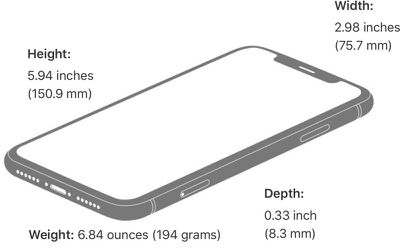
Color Options
Apple has created iPhone XR in six colors, marking the first time since the 2013 iPhone 5c that iPhones were made available in colors other than silver, space gray, gold, and red.
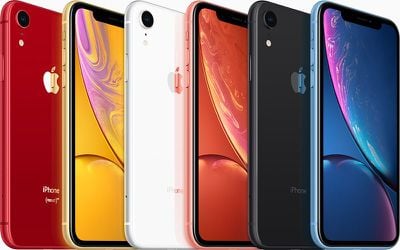
iPhone XR comes in white, black, blue, coral, yellow, and (PRODUCT)RED, with glass bodies and matching anodized aluminum frames.
To go along with the iPhone XR, Apple sells a clear iPhone case that's designed to show off the bright colors of the device. The case was released in December 2018, two months after the launch of the iPhone XR.
Water and Dust Resistance
The iPhone XR is IP67 water and dust resistant, which means that it is impervious to dust and can withstand immersion in water up to one meter (3.3 feet) deep for 30 minutes in laboratory conditions.
Though the iPhone XR can withstand splashes, rain, and brief accidental water exposure, intentional water exposure should be avoided. Apple warns that water and dust resistance are not permanent conditions and could decrease as a result of normal wear.
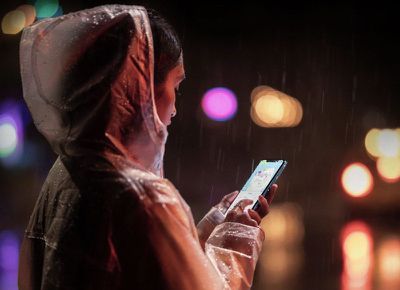
Apple's warranty also does not cover any kind of water damage to iOS devices, so it's best to use caution when exposing the iPhone XR to liquids.
Display
iPhone XR is equipped with the most advanced LCD in a smartphone, which features several technological advancements to make it larger than ever.
Apple says new engineering techniques were created for pixel antialiasing and pixel masking to extend the display to the edges of the device. Apple also used LEDs that fit into a smaller space than ever before along with a new backlight design to make the display larger and able to reach to the corners of the iPhone.

Given the advanced LCD technology in use, Apple has given the display a new Apple-style name: Liquid Retina.
The iPhone XR's display measures in at 6.1 inches and it has a resolution of 1792 x 828 with 326 pixels per inch and 1.4 million total pixels, meaning it is inferior to the OLED display in the iPhone XS models but on par with past iPhones that have used LCDs.
Though not OLED, the iPhone XR's display supports many of Apple's latest technology advancements including Tap to Wake to activate display with a single tap, a swipe-based gesture system to replace the Touch ID Home button, True Tone for matching the white balance of the display to the ambient lighting, and wide color for vivid, true to life colors.
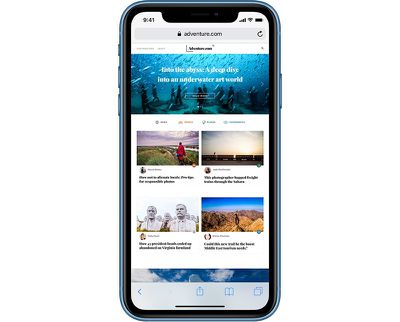
It has a 1400:1 contrast ratio, which is one of the areas where it falls short of the iPhone XS. The XS's OLED display has a 1,000,000:1 contrast ratio. Colors aren't quite as rich nor are blacks quite as black, but it does have the same 625 cd/m² max brightness.
Haptic Touch
Apple eliminated the 3D Touch feature in the iPhone XR and instead replaced it with a new Haptic Touch option, which the company says is similar to the haptic trackpad in the MacBook Pro.
3D Touch is available throughout the iOS 12 operating system and is often used to display additional information through a force press gesture. The same functionality is not available through Haptic Touch, but Haptic Touch does provide feedback when doing things like force pressing on the camera icon on the Lock screen of the iPhone XR or long pressing on notifications (as of iOS 12.1.1).
With the iPhone 11 and 11 Pro release in 2019, Apple eliminated 3D Touch across its flagship lineup, replacing it with the Haptic Touch option introduced in the iPhone XR. Apple has been expanding the number of places where Haptic Touch can be used on the iPhone XR, and in iOS 13, Apple has added 3D Touch-style long press gestures that work on the iPad, iPhone XR, and Apple's newest phones, further signaling the sunsetting of 3D Touch.
A12 Bionic Processor
The iPhone XR is equipped with a new 7-nanometer A12 Bionic chip that's faster and more efficient than the A11 in the previous-generation iPhone X.
There are two high-performance cores in the A12 that are up to 15 percent faster than the A11 Bionic and four efficiency cores that use up to 50 percent less power. The A12, combined with a bigger battery, enables much longer battery life for the iPhone XR.

As with the A11, the A12 can harness all six of its cores at once when a boost in power is needed, and a new performance controller dynamically divides work across the cores for the best performance and battery life.
Apple's A12 Bionic includes a 4-core GPU that offers up to 50 percent faster graphics performance than the A11 chip.
Neural Engine
The A11 Bionic introduced the first Neural Engine, and the A12-chip has a next-generation 8-core version that uses real-time machine learning to power features across the operating system, improving photo taking, gaming, augmented reality, and more.
According to Apple, the Neural Engine is able to perform five trillion operations per second, allowing more to be done in real time. It's what powers the machine learning features in the iPhone XR, like photo search, Face ID, and augmented reality experiences.
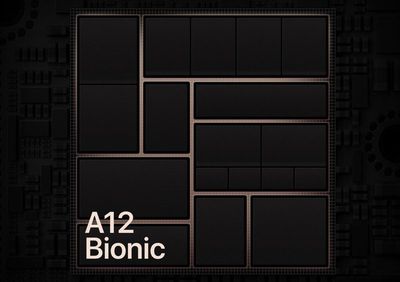
For the first time, Apple has also opened up the Neural Engine to the Core ML platform, which means developers can take advantage of the real-time machine learning features in their apps. With the A12 Bionic, Core ML runs up to nine times faster than on the A11 Bionic.
The A12 Bionic brings faster detection of AR surfaces for the rear camera, better AR experiences for the front-facing camera, immersive 3D gaming experiences, and faster Face ID.
RAM and Storage Space
iPhone XR includes 3 GB RAM, 1 GB less than iPhone XS and XS Max and the same amount of RAM that was in the iPhone X. iPhone XR is available in 64 and 128 GB capacities.
Face ID and the TrueDepth Camera System
Face ID, introduced in 2017 with the iPhone X, is the biometric authentication system used in the iPhone XR, which features a notch housing the TrueDepth camera system that enables Face ID.
Face ID performs the same role as Touch ID, except it uses a facial scan instead of a fingerprint, and Face ID in the iPhone XR is identical to Face ID in the iPhone X with the exception of speed improvements. With the new A12 Bionic chip and Neural Engine improvements, Face ID is able to detect your face and unlock your device faster than before.

Face ID is used across the iOS operating system for tasks like unlocking your iPhone, allowing access to third-party passcode-protected apps, confirming purchases in iTunes and the App Store, and authenticating Apple Pay payments.
Face ID works through a set of sensors and cameras built into the front of the iPhone XR, called the TrueDepth Camera system. To create a facial scan, a Dot Projector projects more than 30,000 invisible infrared dots onto your face, which are then read by an infrared camera.
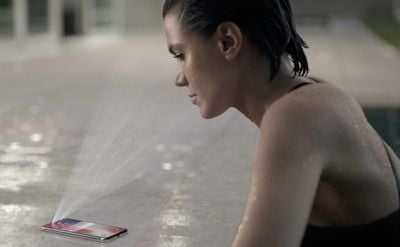
This depth map of your face is then relayed to the A12 Bionic processor where it is transformed into a mathematical model that the iPhone uses to make sure it's you attempting to access your iPhone.
Face ID uses infrared, so it works in low light and in the dark, with a built-in Flood Illuminator making sure there's always adequate light to take a facial scan. Face ID works with hats, beards, glasses, sunglasses, scarves, makeup and all other accessories and items that might partially obscure a face, but it does need to see your eyes, nose, and mouth to work.

The A12 Bionic chip with built-in Neural Engine means that Face ID can adjust to minor facial changes over time, so if you grow your hair longer or grow a beard, Face ID w adjusts and continue to unlock your iPhone. In iOS 12, there is an option to add an alternate appearance if your face changes drastically during the day due to sunglasses, scarves, or other accessories.
Face ID Security and Privacy
Face ID uses a detailed 3D facial scan that's unable to be fooled by a photo, mask, or other facial imitation. An "Attention Aware" security feature allows Face ID to unlock your device only when you look in the direction of the iPhone XR with your eyes open, so it does not work when your eyes are closed, when you're sleeping, when you're unconscious, or when you're looking away from your phone.
Attention aware is optional and there is an accessibility feature to turn it off for those who are unable to focus on the iPhone's screen, but most people should leave it turned on for the added layer of security.
With the attention aware feature, the iPhone XR knows when you're looking at it. Face ID displays notifications and messages on the Lock screen when you look at the iPhone XR, it keeps the screen lit, and it automatically lowers the volume of an alarm or ringer when it knows your attention is on the iPhone XR's display.

If a thief demands your iPhone, Face ID can be disabled quickly and discretely by pressing on the side button and the volume button at the same time. Do this before handing your phone over, and a thief won't be able to scan your face. Face ID also turns off after two failed facial recognition attempts and a passcode needs to be entered for it to be turned back on.
Face ID data is encrypted and stored in the Secure Enclave on the iPhone XR. Apple can't access your Face ID data, nor can anyone who has your phone. Authentication happens entirely on your device, with no Face ID data ever stored in the cloud or uploaded to Apple. Third-party developers do not have access to the facial map that Face ID uses to unlock a device, but the TrueDepth camera can be used to scan a user's face for the purpose of creating more realistic augmented reality apps.
With Face ID, there's a 1 in 1,000,000 chance that someone else's face can fool Face ID, but the error rate increases to 1 in 1 in 500,000 with an alternate appearance registered in iOS 12. Face ID has been fooled by identical twins, children, and a carefully crafted mask, but it's still secure enough that the average person does not need to worry about their iPhone being unlocked by someone else.
TrueDepth Camera Specs
The TrueDepth Camera, in addition to powering Face ID with the infrared additions, is also a standard 7-megapixel front-facing camera that can be used for selfies and FaceTime calls. As of iOS 14.2, FaceTime calls are streamed in 1080p over WiFi connections.

The front-facing camera in the iPhone XR supports several new features, including Smart HDR for portraits that capture more detail in shadows and highlights and a new Depth Control feature that lets you adjust the amount of blur in a front-facing Portrait Mode image after it's captured, or, as of iOS 12.1, when composing an image in real-time.
As with the iPhone X, wide color and Portrait Lighting features are available so you can adjust the lighting in your photos. There is, however, improved bokeh for better DSLR-style blurring in your images.
The TrueDepth camera can be used to capture 1080p HD video at 30 or 60 frames per second.
Animoji and Memoji
The TrueDepth Camera System supports two features called "Animoji" and "Memoji," which are animated, 3D emoji characters that you control with your face. Animoji are emoji-style animals, while Memoji, introduced in iOS 12, are customizable, personalized avatars that you can create.
To enable Animoji and Memoji, the TrueDepth camera analyzes more than 50 muscle movements in different areas of the face, detecting movement of the eyebrows, cheeks, chin, eyes, jaw, lips, eyes, and mouth.
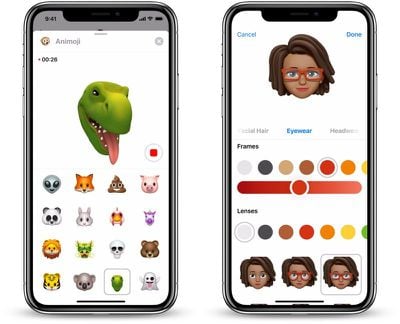
All of your facial movements are translated to the Animoji/Memoji characters, letting them reflect your expression and emotion. Animoji and Memoji can be shared with friends and used in the Messages and FaceTime apps.
There are more than a dozen different Animoji to choose from, modeled after existing emoji characters: monkey, robot, cat, dog, alien, fox, poop, pig, panda, rabbit, chicken, unicorn, lion, dragon, skull, bear, tiger, koala, t-rex, and ghost. There are an unlimited number of Memoji that can be created to look like you and other people.
Rear Camera
iPhone XR uses a single-lens camera system, but it is the most advanced single-lens camera Apple has designed, combining the latest hardware with some impressive software advancements to enable features that were not previously possible.
The iPhone XR is using the same f/1.8 12-megapixel wide-angle camera that's in the iPhone XS and XS Max, and that camera, compared to the camera in the previous-generation iPhone X, features a 32 percent larger sensor with bigger pixels to allow for clearer, crisper photos even in conditions where lighting is poor.
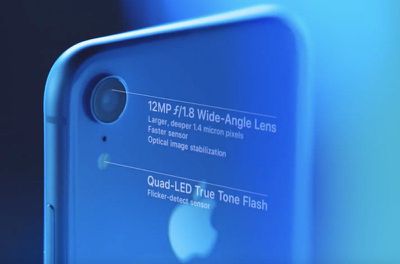
It also features twice as many focus pixels, includes optical image stabilization for photos and videos, offers wide color, and it features the same improved quad-LED True Tone flash with slow sync. The lens of the wide-angle camera is equivalent to 26 mm, which means it offers a slightly wider field of view than the camera in the iPhone X.
Machine learning techniques powered by the A12 Bionic allow the iPhone XR to recognize people, map subjects, and add depth, all of which allow for a Portrait Mode feature for the rear camera that does not require two lenses.
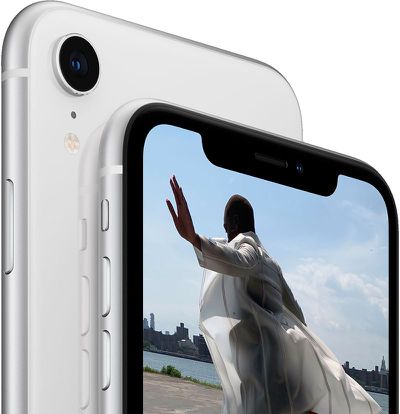
Portrait Mode is enabled through a software feature that creates a depth segmentation map using the camera's focus pixels and neural net software to separate the subject of a photo from the background.
Portrait Lighting is also enabled through this technique, but a limited number of effects are available. Users can choose Natural, Studio, or Contour lighting options, but Stage Light and Stage Light Mono effects included on other iPhone models with dual cameras are not available on iPhone XR.
In addition to Portrait Mode, iPhone XR features advanced bokeh for better background blurring, Depth Control for adjusting the field of view after an image has been captured, and Smart HDR to bring out more detail in the highlights and shadows of images especially in low-light situations.
Because there's no second telephoto lens to enable optical zoom, iPhone XR's camera maxes out at 5x digital zoom.
Video Capabilities
iPhone XR can record 4K video at 24, 30, or 60 frames per second, 1080p HD video at 30 or 60 frames per second, or 720p HD video at 30 frames per second.
Extended dynamic range is available for video up to 30 frames per second, and when capturing video, digital zoom up to 3x is available.
It supports 1080p Slo-mo video at 120 or 240 frames per second, time-lapse video, and 1080p and 720p cinematic video stabilization. Stereo recording is included, as is stereo playback with new wider sound separation.
Apple with iOS 14 updated the iPhone XR and iPhone XS models with QuickTake, which is a feature that lets you capture a video while the Camera app is in photo mode so you don't need to waste time switching modes. For instructions on how to use QuickTake, make sure to check out our how to.
Battery Life
The iPhone XR has a 2,942 mAh battery, 8.3 percent larger than the battery in the iPhone X and 10.6 percent larger than the battery in the iPhone XS, but somewhat smaller than the 3,174 mAh battery in the iPhone XS Plus.
Though it doesn't have the largest battery of Apple's three 2018 iPhones, the iPhone XR has the longest battery life, lasting an hour and a half longer than the battery in the iPhone 8 Plus. The iPhone XR offers up to 25 hours of talk time, up to 15 hours of internet use, up to 16 hours of video playback, and up to 65 hours of audio playback.
Fast Charging
iPhone XR is fast-charge capable, which means it can be charged to 50 percent battery life in just 30 minutes. Fast charging requires a USB-C power adapter that offers at least 18 watts, which includes 29/30W adapters from Apple (priced at $49). Third-party 18W+ USB-C adapters also work, but the Lightning to USB-C cables must be purchased from Apple for $19.
Wireless Charging
Support for wireless charging was first introduced in Apple's 2017 iPhone lineup, and the iPhone XR continues to offer glass bodies and built-in wireless charging coils to support wireless charging functionality.
Apple uses the Qi wireless charging standard that's also available in many Android phones, which means the new iPhones can charge wirelessly with any Qi-certified inductive charger.
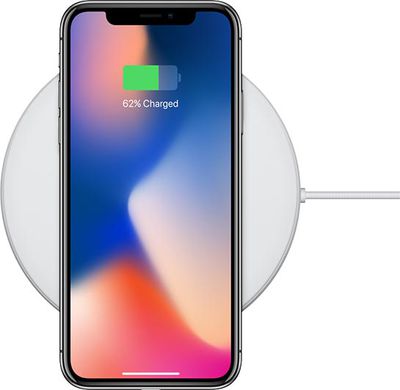
According to Apple, iPhone the iPhone XR charges "even faster" than the iPhone X, and there is a copper coil inside that facilitates slightly faster charging because it doesn't heat up quite as much.
iPhone XR works with 7.5W and 5W wireless charging accessories. Multiple companies have now developed wireless charging options designed specifically for Apple's iPhones.
7.5W charging is faster than 5W charging, but the difference is not hugely noticeable. Wireless charging is also generally inferior to wired charging, which is almost always faster. We tested multiple wired and wireless charging methods and while 7.5W charging is faster than 5W wired charging, the best way to charge an iPhone is using a 12W iPad power adapter or an 18W+ option, which enables fast charging capabilities.
Connectivity
LTE Advanced
iPhone XR supports LTE Advanced for data transfer speeds up to 450Mb/s. It works with more than 20 LTE bands, with Apple using a single model for all cellular networks.

Dual-SIM Support
The iPhone XR models sold around the world feature dual-SIM support, which allows two phone numbers to be used at one time.
Dual-SIM functionality is enabled through the inclusion of one physical nano-SIM slot and an eSIM, a feature that was first introduced in the iPad. eSIM support was enabled with the iOS 12.1 update, making dual-SIM functionality available through the existing physical SIM and the new eSIM. Carriers need to implement support for eSIM functionality for the feature to work, and in the United States, Verizon and AT&T offer eSIM support as of December 2018.
The eSIM feature is available in many countries around the world, and Apple has a full list of carriers that support eSIM on its website.
Dual-SIMs work with select carriers in Austria, Canada, Croatia, Czech Republic, Germany, Hungary, India, Spain, the UK, and the United States.
In China, where eSIMs are not allowed, iPhone XR devices feature two physical SIM card slots. Models with two SIM slots are limited to China and won't be sold elsewhere.
Bluetooth and Wi-Fi
iPhone XR supports the Bluetooth 5.0 standard. Bluetooth 5.0 offers longer range, faster speeds, larger broadcast message capacity, and better interoperability with other wireless technologies.
Compared to Bluetooth 4.2, Bluetooth 5 offers four times the range, two times the speed, and eight times the broadcast message capacity.
802.11ac Wi-Fi with 2x2 MIMO is supported, with support for connection speeds that can reach a theoretical maximum of 866Mb/s.
GPS and NFC
Support for GPS, GLONASS, Galileo, and QZSS location services is included in the iPhone XR.
NFC with reader mode is included, and for the first time, the iPhone XR includes a background tag feature that allows them to scan NFC tags without the need to open an app first.
How To Get Home On Iphone Xr
Source: https://www.macrumors.com/roundup/iphone-xr/
Posted by: shafferwhow1970.blogspot.com

0 Response to "How To Get Home On Iphone Xr"
Post a Comment